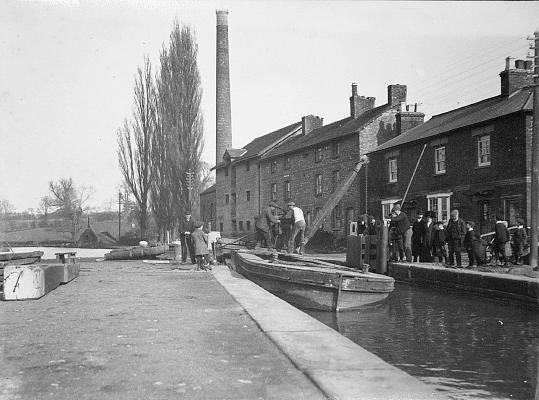 An old photograph from the Northamptonshire
Record Office (George Freeston Collection) illustrates a broad beam boat with a lifting boom gantry being
used to assist in gate replacement at Stoke Bruerne top lock.
An old photograph from the Northamptonshire
Record Office (George Freeston Collection) illustrates a broad beam boat with a lifting boom gantry being
used to assist in gate replacement at Stoke Bruerne top lock.PICTURES ON MAINTENANCE WORKS
Quite a few of these pictures are also present in the Canal and Miscellaneous pages indexed on the homepage - it does no harm to repeat them here!
Replacing Lock Gates:
 An old photograph from the Northamptonshire
Record Office (George Freeston Collection) illustrates a broad beam boat with a lifting boom gantry being
used to assist in gate replacement at Stoke Bruerne top lock.
An old photograph from the Northamptonshire
Record Office (George Freeston Collection) illustrates a broad beam boat with a lifting boom gantry being
used to assist in gate replacement at Stoke Bruerne top lock.
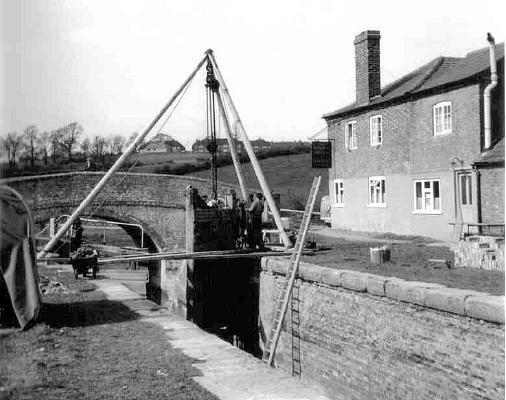 In more recent years what was called the three
legs hoist was used at Braunston and might still be available where the location
is inaccessible.
In more recent years what was called the three
legs hoist was used at Braunston and might still be available where the location
is inaccessible.
 When mobile cranes became more readily available
and access to locks improved, a crane proved a suitable means of lifting the
heavy gates and balance beams [Stoke Bruerne].
When mobile cranes became more readily available
and access to locks improved, a crane proved a suitable means of lifting the
heavy gates and balance beams [Stoke Bruerne].
Bank Protection:
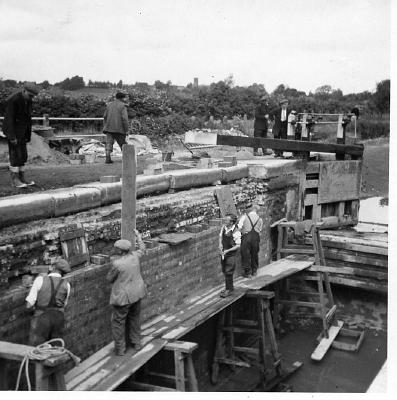 The sides of the locks would normally comprise
blue bricks and in later times concrete
was frequently used, this image illustrates the trestle and plank arrangement
used to gain access to worn lock sides [Stoke Bruerne].
The sides of the locks would normally comprise
blue bricks and in later times concrete
was frequently used, this image illustrates the trestle and plank arrangement
used to gain access to worn lock sides [Stoke Bruerne].
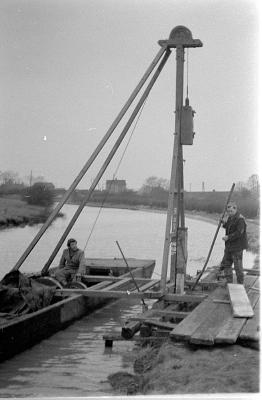 With the increase in motorised craft bank erosion
increased significantly becoming a major expense, concrete and steel piles are
used extensively as illustrated here with a simple piling frame driving concrete
piles between Candle (No. 50) and Stockwell (Stockle) bridges.
With the increase in motorised craft bank erosion
increased significantly becoming a major expense, concrete and steel piles are
used extensively as illustrated here with a simple piling frame driving concrete
piles between Candle (No. 50) and Stockwell (Stockle) bridges.
David Blagrove says "The man standing to the right holding a pole is Frank ("Craney") Smith of Stoke Bruerne. Frank supposedly acquired his nickname as a youth from his ability to lift heavy weights. In later years he drove the steam dredger based at Gayton, which through various vicissitudes has ended up unloved and uncared for at Ellesmere Port Museum. The steam dredger, see below, ceased to be used by BW after 1963/4 and Craney then went to work with the piling gang."
 A section of completed pile driving, the piles are tied back with rods to
concrete blocks formed in the towpath, redundant sections of railway line being
fitted to the front of the pile and the surface is made good with backfilling.
A section of completed pile driving, the piles are tied back with rods to
concrete blocks formed in the towpath, redundant sections of railway line being
fitted to the front of the pile and the surface is made good with backfilling.
On the horizon, the village of Blisworth, the chimney of the bacon factory a prominent landmark.
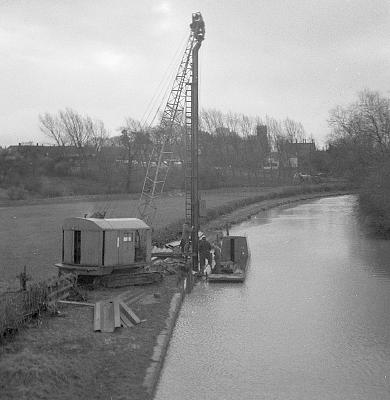 The forming of an overflow weir south of Candle bridge was a relatively large
project which was outsourced by B.W. whereas in G.U.C.C. days it might well have
been designed and built by local staff.
The forming of an overflow weir south of Candle bridge was a relatively large
project which was outsourced by B.W. whereas in G.U.C.C. days it might well have
been designed and built by local staff.
On completion of the weir, the small overflow to the north of the bridge which had allowed water to pass beyond Candle Cottage was closed (but not actually infilled until 1991 when heavy flooding brought incomplete works to B.W's attention). The ground paddle adjacent to the weir is now little used as the weir maintains the required water level.
 The background to the completed weir is of
interest as it shows part of the field before the Pondbank development and in
the distance the paddock areas running down from the Royal Oak, 38, High St. and
the rear of Burbidge's premises which formed part of Westbrook.
The background to the completed weir is of
interest as it shows part of the field before the Pondbank development and in
the distance the paddock areas running down from the Royal Oak, 38, High St. and
the rear of Burbidge's premises which formed part of Westbrook.
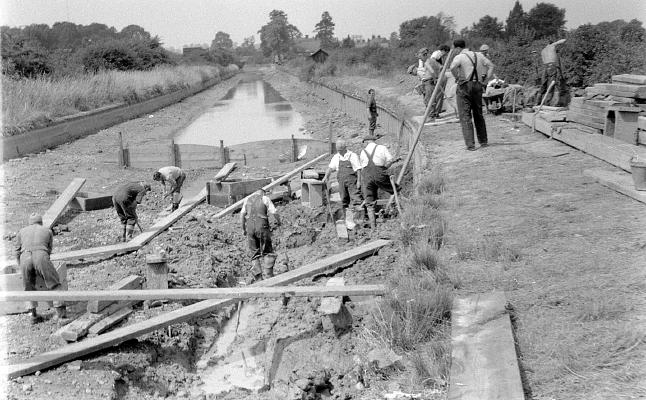 A leak from the canal causes problems and bank
erosion increased with the use of powered craft. Similarly, animals
burrowing in the bank may allow eventual water ingress whilst piling can be a
solution. The use of clay puddle is one of the traditional solutions.
Weedon Bank is probably the greatest potential threat locally and the image
depicts remedial works in the ‘60s where, despite steel piling, more concrete
and clay had to be installed during a stoppage.
A leak from the canal causes problems and bank
erosion increased with the use of powered craft. Similarly, animals
burrowing in the bank may allow eventual water ingress whilst piling can be a
solution. The use of clay puddle is one of the traditional solutions.
Weedon Bank is probably the greatest potential threat locally and the image
depicts remedial works in the ‘60s where, despite steel piling, more concrete
and clay had to be installed during a stoppage.
 Leak stoppage at Weedon Bank: this illustrates the problem of two six feet tall
maintenance workers manually digging down in a relatively small pit below
surface level
against the interlocking steel piles and then barrowing in sufficient puddle
clay to stop the leak.
Leak stoppage at Weedon Bank: this illustrates the problem of two six feet tall
maintenance workers manually digging down in a relatively small pit below
surface level
against the interlocking steel piles and then barrowing in sufficient puddle
clay to stop the leak.
 Sources of clay can be problematical as not all
clay is suitable. Before the Marina was constructed on the Arm next to the old
petrol depot, a large bund of clay was built on the waters edge in readiness for
collection by maintenance crews. The land here was acquired at Millner's
suggestion at the time of
the 1919 Grafton Sale, being adjacent to the canal yard and easy to develop.
Sources of clay can be problematical as not all
clay is suitable. Before the Marina was constructed on the Arm next to the old
petrol depot, a large bund of clay was built on the waters edge in readiness for
collection by maintenance crews. The land here was acquired at Millner's
suggestion at the time of
the 1919 Grafton Sale, being adjacent to the canal yard and easy to develop.
Dredging:
 Dredging becomes necessary following bank erosion
to maintain a suitable depth of water for navigation. Early types
of dredger were known as spoon dredgers but the use of steam machines proved
superior. This illustration from the Northampton Record Office shows an early
model at work at the Arm End.
Dredging becomes necessary following bank erosion
to maintain a suitable depth of water for navigation. Early types
of dredger were known as spoon dredgers but the use of steam machines proved
superior. This illustration from the Northampton Record Office shows an early
model at work at the Arm End.
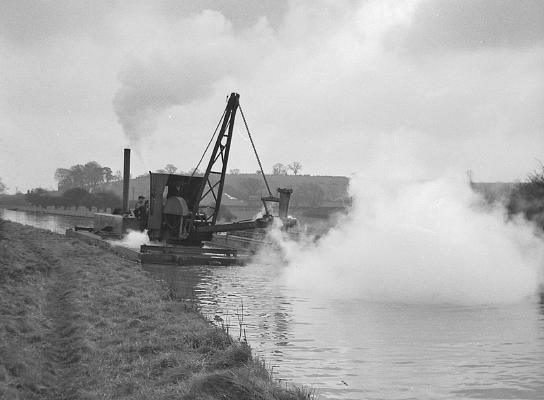 A later steam dredger working near Banbury Lane
in the 60s.
A later steam dredger working near Banbury Lane
in the 60s.
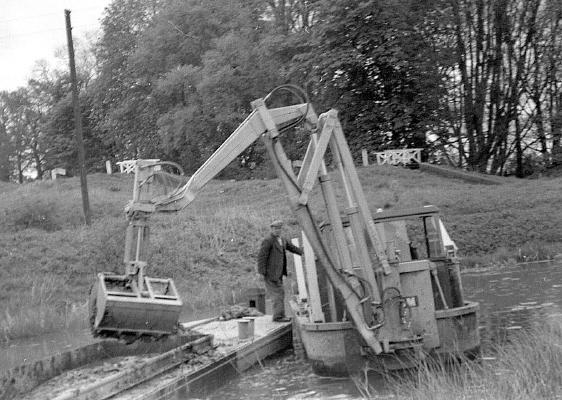 The Dinkum dredger proved ideal for working on
narrow canals and in areas with restricted accessibility such as this work in
the side ponds at Watford locks, where the support legs could be raised and
lowered as required.
The Dinkum dredger proved ideal for working on
narrow canals and in areas with restricted accessibility such as this work in
the side ponds at Watford locks, where the support legs could be raised and
lowered as required.
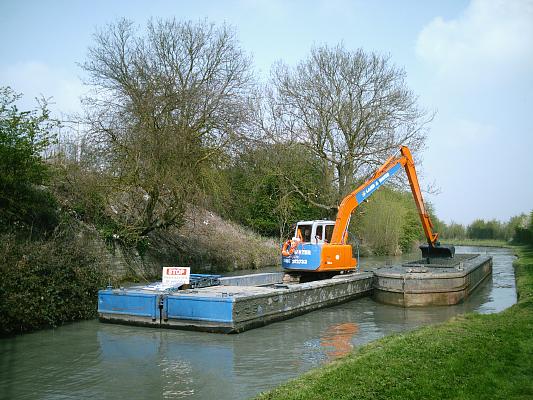 In 2005 works were regularly outsourced and Land
and Water were using a modern pontoon mounted hydraulic machine when working at
Blisworth in readiness for the tunnel bicentenary event.
In 2005 works were regularly outsourced and Land
and Water were using a modern pontoon mounted hydraulic machine when working at
Blisworth in readiness for the tunnel bicentenary event.
Ice Breaking:
 Before powered boats became available ice had to be broken by a specially
designed craft fitted with a platform and a horizontal bar or in this case a
tensioned rope to enable the crew to rock the boat and assist with breaking the
ice. Horses in teams to a maximum number of twenty four were used to haul the
boat through or onto the ice
Before powered boats became available ice had to be broken by a specially
designed craft fitted with a platform and a horizontal bar or in this case a
tensioned rope to enable the crew to rock the boat and assist with breaking the
ice. Horses in teams to a maximum number of twenty four were used to haul the
boat through or onto the ice
Other ice breaking boats are mentioned in some of Millner's letters.
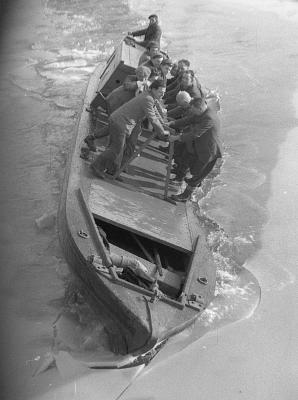 On 7th January 1962 a large crew of
“rockers” and a powerful tug was at last able to break the ice which
was four inches [100mm] thick in places. This enabled commercial boat crews to
start moving as if they couldn’t deliver their cargoes they remained unpaid.
On 7th January 1962 a large crew of
“rockers” and a powerful tug was at last able to break the ice which
was four inches [100mm] thick in places. This enabled commercial boat crews to
start moving as if they couldn’t deliver their cargoes they remained unpaid.
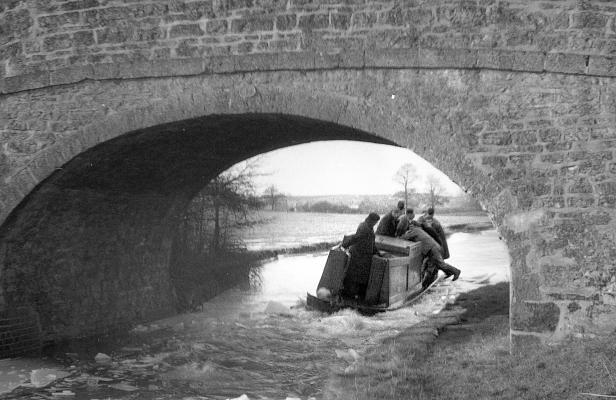 As the tug passed under Wrights Lane bridge one
crew member appears to have completely lost his footing.
As the tug passed under Wrights Lane bridge one
crew member appears to have completely lost his footing.
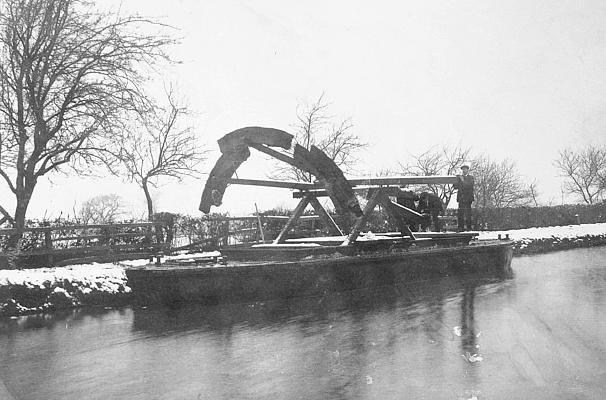 From the early days the tunnel needed maintenance
with brickwork repairs and once the steam tugs were introduced the tunnel was
swept with a special boat mounted brush arrangement invented c. 1910 by Thomas
Millner.
From the early days the tunnel needed maintenance
with brickwork repairs and once the steam tugs were introduced the tunnel was
swept with a special boat mounted brush arrangement invented c. 1910 by Thomas
Millner.
 In
the 60s frequent operations to replace worn or damaged
brickwork were carried out, initially using
completely manual methods.
In
the 60s frequent operations to replace worn or damaged
brickwork were carried out, initially using
completely manual methods.
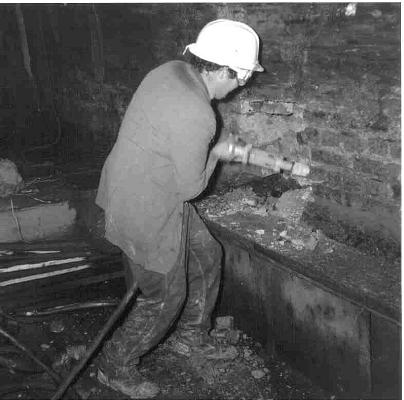 In later years compressed air tools were employed
with the compressed air being provided from the ground level above with hoses
fed down the tunnel ventilator chimneys.
In later years compressed air tools were employed
with the compressed air being provided from the ground level above with hoses
fed down the tunnel ventilator chimneys.
 There was an attempt to preserve the face of the
brickwork using a reinforcement mesh fastened to the wall and using Guniting and
the Aerocem process.
There was an attempt to preserve the face of the
brickwork using a reinforcement mesh fastened to the wall and using Guniting and
the Aerocem process.
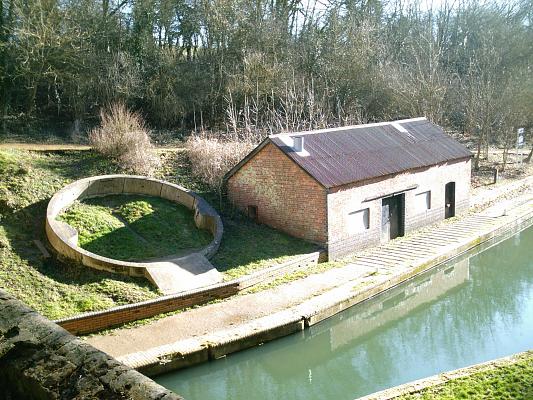 Eventually in the early 80’s
the deterioration of the central section of Blisworth tunnel became so
bad that navigation was closed and a specialist contractor,
Mowlems, was brought
in. They designed and built sophisticated equipment which enabled the
renewal of the bore with pre-cast concrete sections. The tunnel was
reopening in 1984. One of these sections has been installed in the bank at the
southern end of the tunnel, adjacent to the leggers hut and stables giving an
idea of the completed task.
Eventually in the early 80’s
the deterioration of the central section of Blisworth tunnel became so
bad that navigation was closed and a specialist contractor,
Mowlems, was brought
in. They designed and built sophisticated equipment which enabled the
renewal of the bore with pre-cast concrete sections. The tunnel was
reopening in 1984. One of these sections has been installed in the bank at the
southern end of the tunnel, adjacent to the leggers hut and stables giving an
idea of the completed task.
Lock Keepers:
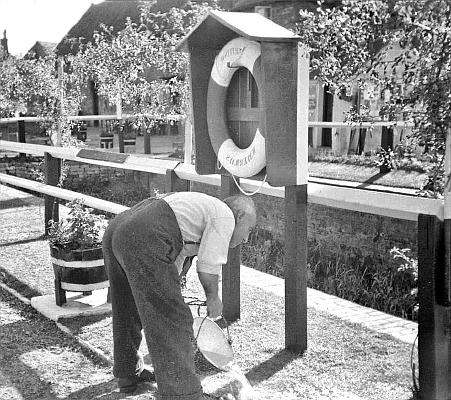 Flights of locks usually had permanent lock keepers. Jack James became the
keeper at Stoke Bruerne in 1947 after working on the River Thames and Oxford
canal. Under his tenure the flight was generally tidied and smartened.
Particular attention was given to the top lock with mown lawns and beds of
flowers.
Flights of locks usually had permanent lock keepers. Jack James became the
keeper at Stoke Bruerne in 1947 after working on the River Thames and Oxford
canal. Under his tenure the flight was generally tidied and smartened.
Particular attention was given to the top lock with mown lawns and beds of
flowers.
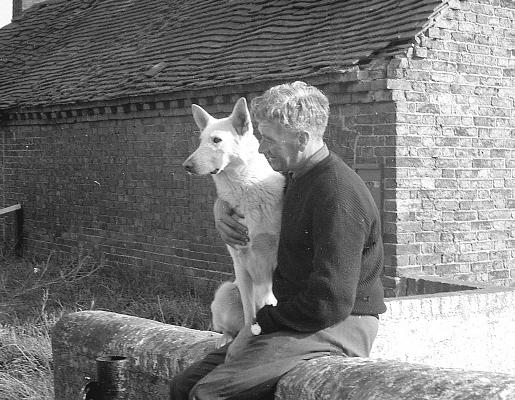 Henry Grantham senior retired in 1941 selling his boats to Barlows. It was
assumed that his son, also a Henry, would go with the boats although he had
other ideas. He tried to join the Navy but, as boating was a reserved
occupation, he was rejected so took work on a pair of GUCCC boats.
Henry Grantham senior retired in 1941 selling his boats to Barlows. It was
assumed that his son, also a Henry, would go with the boats although he had
other ideas. He tried to join the Navy but, as boating was a reserved
occupation, he was rejected so took work on a pair of GUCCC boats.
Whilst working through the locks he slipped and fell between the motor and butty suffering serious injuries. He survived although always walking with a limp and became a lock keeper on the Buckby flight near the family home which was notable for the large Measham-ware teapot kept in the front window.